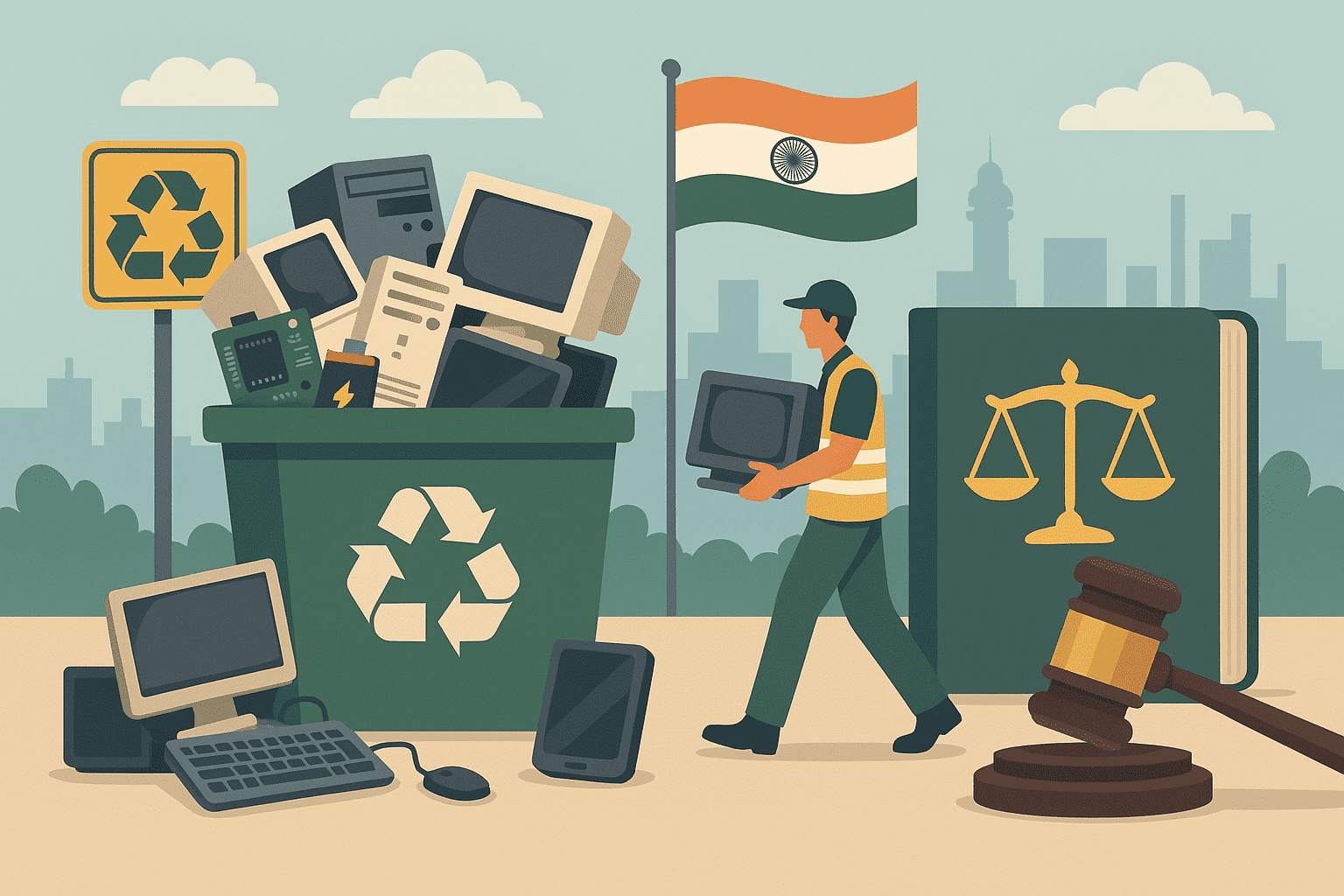Electronic garbage, or “e-waste,” is a serious environmental problem brought on by the widespread use of electronic gadgets and their quick obsolescence. Because it contains dangerous materials, e-waste—which comprises abandoned electrical or electronic gadgets and components—poses serious threats to human health and the environment. The issue of e-waste in India is made worse by a lack of knowledge, inadequate infrastructure, and lax enforcement of the law. This study looks at how e-waste is currently generated and managed in India, analyzes the laws that have been put in place to control it, and makes recommendations for an efficient and sustainable e-waste management plan.
1. Introduction-
Electronic gadgets are now widely used all over the world as a result of the technological revolution. Electronic garbage, or “e-waste,” has becoming a major problem as the demand for contemporary gadgets rises. Discarded electronic devices, including computers, cell phones, televisions, refrigerators, and other devices, are referred to as e-waste. The management of these devices is an important environmental problem since they include both useful and dangerous components.
After the US and China, India is currently the third-largest producer of e-waste. In 2021, the nation produced almost 1.6 million tons of e-waste, and forecasts show that this amount will sharply increase in the years to come. Despite numerous initiatives, uncontrolled recycling methods, low knowledge, and regulatory framework flaws make managing e-waste a major concern.
2. Understanding E-waste: Composition and Impact
E-waste is a mixture of dangerous substances including lead, mercury, cadmium, and brominates flame retardants, as well as recyclable items like metals, plastics, and glass. Inappropriate handling of these materials can result in serious health risks and environmental contamination.
Environmental Impact: Ecosystems can get contaminated by toxic materials included in e-waste that seep into groundwater and soil. Toxic vapors are released into the atmosphere during informal recycling procedures, which frequently entail burning or acid-leaching.
Impact on Health: Respiratory issues, skin conditions, neurological damage, and even cancer can result from exposure to dangerous e-waste components. Children and other workers in the unorganized sector are particularly vulnerable.
3. E-waste Generation in India
The following factors are driving the exponential increase in e-waste generation:
Quick development of technology
An increase in the use of electronics
Reduced life spans of products
Insufficient repair culture
The rise in middle-class customers
The Central Pollution Control Board (CPCB) reports that 1,014,961.2 tons of e-waste were produced in India year 2019–20. Bengaluru, Chennai, Kolkata, Delhi, Mumbai, and other cities are the main contributors.
4. Legal and Regulatory Framework for E-waste Management in India
India took action to create special laws and regulations to combat e-waste after realizing its importance at a reasonably early age. The following succinctly describes the development of the legal framework:
4.1 Hazardous Waste (Management and Handling) Rules, 1989
These regulations first addressed e-waste, but they lacked a precise definition or focused approach to managing it.
4.2 E-Waste (Management and Handling) Rules, 2011
This was the first attempt to deal directly with e-waste. Producers are now in charge of collecting and disposing of e-waste thanks to the regulations’ introduction of the Extended Producer Responsibility (EPR) concept. However, because of insufficient oversight and enforcement systems, these regulations were not very successful.
4.3 E-Waste (Management) Rules, 2016
These regulations provide a stronger foundation and took the place of the 2011 version. Important characteristics include:
Applicability: Broadened to include producers, manufacturers, customers, dealers, e-retailers, collection centers, recyclers, refurbishers, and dismantlers.
Extended Producer Responsibility (EPR): Requires manufacturers to handle e-waste responsibly.
Authorization: The CPCB must provide authorization to producers and recyclers.
Collection Goals: Manufacturers are required to satisfy e-waste collection goals, which increase from 30% of the expected amount in the first two years to higher levels after that.
State Pollution Control Boards (SPCBs) are in charge of keeping an eye on compliance.
4.4 E-Waste (Management) Amendment Rules, 2018
Provisions for consumer awareness, simplified objectives, and acknowledgment of informal sectors were among the amendments made to make compliance easier. The regulations place a strong emphasis on the necessity of recycling and dismantling procedures that respect the environment.
5. Implementation Challenges
India has a very extensive legal system, but there are still a number of obstacles to overcome before e-waste management can be implemented successfully:
5.1 Informal Sector Dominance
The unorganized sector handles a sizable amount of e-waste in crude and dangerous ways. Effective management is hampered by the formal and informal sectors’ lack of synergy.
5.2 Lack of Awareness
Many consumers, especially in rural and semi-urban areas, are unaware of the health and environmental hazards posed by e-waste or their responsibilities under EPR guidelines.
5.3 Inadequate Infrastructure
The infrastructure for recycling, storage, and collection is woefully insufficient. There are few authorized recyclers, and in many places, reverse logistics networks are either nonexistent or very inadequate.
5.4 Ineffective Monitoring and Enforcement
Insufficient personnel, a lack of technological competence, and a lack of collaboration between federal and state authorities make it difficult to implement e-waste regulations.
6. Role of Judiciary and Policy Initiatives
The management of e-waste is one area of environmental law that has been actively shaped by the Indian court.
6.1 Notable Judicial Interventions
Science and Technology Research Foundation Union of India v. National Resource Policy (2005): The government was ordered by the Supreme Court to control the entry of hazardous garbage and guarantee adherence to international agreements.
The courts have advocated for improved enforcement of environmental rules and underlined the “Polluter Pays” principle.
6.2 Policy Measures and Programs
The Digital India Initiative indirectly encourages the prudent use and disposal of technological devices.
E-waste management is indirectly aided by the Swachh Bharat Abhiyan, which promotes cleaner cities and garbage segregation.
Start-up India and Make in India: Promote formal sector involvement and technological innovation in recycling.
7. Global Best Practices and Lessons for India
E-waste management systems have been effectively adopted in a number of nations. Some of these best practices are suitable for adoption and adaptation in India:
European Union: All forms of e-waste must be collected, recycled, and recovered, and producers are subject to stringent obligations under the EU’s WEEE Directive.
Japan: Puts in place a consumer-funded take-back program run by manufacturers with stringent recycling targets.
South Korea: Features cutting-edge IT-enabled tracking systems for the processing and transportation of e-waste.
India requires improved data gathering, incentives for official recyclers to increase efficiency, and a transparent, technologically advanced tracking system.
8. Recommendations for Effective E-waste Management
8.1 Strengthening the Legal Framework
Regular revisions to the regulations to include new e-waste classifications
Explicit sanctions for noncompliance
Increased involvement of local government agencies
8.2 Formalizing the Informal Sector
Informal recyclers’ integration into the official industry and their training
providing small-scale handlers with incentives and registration efforts
8.3 Infrastructure Development
Establishing more facilities for recycling and approved collection centers
Building urban mining clusters and reverse logistical networks
8.4 Public Awareness and Education
Starting awareness initiatives around the country
incorporating instruction on e-waste into curricula at schools and universities
8.5 Incentivizing EPR Compliance
Granting tax breaks or incentives to businesses that reach or surpass EPR goals
promoting public-private collaborations for infrastructure recycling
Conclusion-
India’s approach to managing e-waste is at a turning point. Even though the legal system has changed significantly over time, these rules are still not being implemented and enforced effectively enough. There are still holes in the infrastructure, and the informal sector still predominates. A multi-stakeholder strategy encompassing government agencies, producers, recyclers, consumers, and the courts is necessary for India to handle e-waste sustainably.
In addition to protecting the environment and public health, effective e-waste management creates new business prospects in the recycling sector. India can turn its e-waste problem into a success story for the green and circular economy by enhancing local regulations and taking inspiration from international best practices.
References-
- Central Pollution Control Board (CPCB), Annual Report on E-waste, 2021
- E-Waste (Management) Rules, 2016 and Amendments
- Ministry of Environment, Forest and Climate Change (MoEF&CC) official website
- Research Foundation for Science Technology v. Union of India, (2005) 10 SCC 510
- European Union WEEE Directive
- “E-waste in India” – ASSOCHAM-KPMG Report, 2020
- International Telecommunication Union (ITU) Global E-Waste Monitor, 2020
– Dr. Dushyant Kumar, Associate Professor
Faculty of Law, Madhav University, Pindwara, Sirohi

